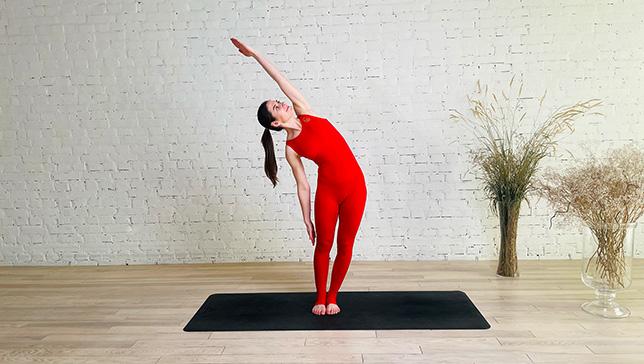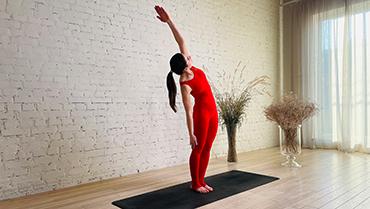Sideways Bending – One Arm - Konasana

Contents
Sideways Bending with One Arm Up, Angle Pose, or Konasana is a basic standing pose that stretches the spine and obliques and promotes better posture. This pose also strengthens the legs. If you are looking to stand taller and look leaner you should learn how to do Sideways Bending.
Many if not most of us suffer from poor posture. Slouching over a computer or steering wheel and walking around with our head hanging over a cell phone has taught our backs to curve forward, our chest to be tight and our neck to be out of alignment. The only way to fix this posture that will eventually lead to a hump back, also known as kyphosis, is to re-align your spine and practice better posture.
Konasana opens the entire torso and encourages you to stand taller. By taking a side bend without leaning either forward or backward – even slightly – you open up the muscle tissue surrounding your spine and your rib cage and you encourage a taller stance.
Pose Detail
- Difficulty: Beginners
- By Type: Flexibility Yoga Poses, Shoulder Opening Yoga Poses, Strengthening Yoga Poses
- Body Position: Lateral Bend Yoga Poses, Standing Yoga Poses
- By Benefit: Yoga Poses For Anxiety And Panic Attack, Yoga Poses For Digestion, Yoga Poses For Stress Relief
Step-by-Step Instructions
Benefits and Contraindications
Stretches the sides of the body and the spine
Tones the arms, legs, and abdominal organs
Reduces the waistline
Improves blood circulation in the body
Stimulates the nervous system and alleviates nervous depression
Pregnant women (in 2nd and 3rd trimester)
Arthritis
Severe back pain
Spinal injury or disorders
Severe cardiac problems
Photo poses in different angles

Modifications, Props and Tips
- As you bend your torso to the side, be sure to keep your shoulders relaxed and down away from your ears.
- To help you maintain balance in this posture, engage your core muscles. Draw your navel towards your spine and lengthen your torso.
- Remember to breathe deeply and evenly as you hold the stretch, inhaling to lengthen the spine and exhaling to deepen the stretch.
Frequently Asked Questions
Yes, Konasana pose can be helpful for reducing lower back pain. This posture can help to stretch and strengthen the muscles of the legs, hips, and lower back, which can relieve tension and improve spinal alignment.
When practicing Konasana, focus on keeping your spine long and your hips level. Avoid rounding your back or collapsing your chest forward. Instead, engage your core muscles and lengthen through the crown of your head. You can also use a block or a folded blanket under your bottom hand to help maintain proper alignment.
Regular practice of Konasana can help to release tension in the muscles of the lower back and hips, which can alleviate pain and improve mobility. However, if you have a serious or chronic lower back condition, it is important to consult with a healthcare professional before starting any new exercise program, including yoga.
Konasana pose can be challenging for people with knee or hip issues, especially if there is limited range of motion or pain in these areas. It is important to approach the pose with caution and to modify as needed.
For people with knee issues, it may be helpful to practice Konasana with a bent front knee, rather than straightening the leg. This can help to reduce pressure on the knee joint. It may also be helpful to use a block under the hand or to practice against a wall for support.
For people with hip issues, it is important to avoid pushing too deeply into the pose. Focus on maintaining a comfortable stretch in the hips and legs, rather than pushing beyond your limits. You may also find it helpful to use a block or a folded blanket under your bottom hand for support.
As with any yoga posture, it is important to listen to your body and to avoid any movements or positions that cause pain or discomfort. If you have a serious or chronic knee or hip condition, it is important to consult with a healthcare professional before practicing Konasana or any other yoga postures.
Konasana pose can be particularly beneficial for runners and other athletes, as it helps to stretch and strengthen the legs, hips, and torso.
Here are some ways that Konasana pose can benefit runners and athletes:
- Improves flexibility: Regular practice of Konasana can help to increase flexibility in the hamstrings, hips, and groin. This can improve overall mobility and range of motion, which is important for athletic performance.
- Strengthens the legs: Konasana requires engagement of the muscles of the legs, particularly the quadriceps and hamstrings. Regular practice can help to build strength and endurance in these muscles, which can improve running and athletic performance.
- Stretches the side body: The lateral stretch of Konasana helps to lengthen the muscles of the side body, including the obliques and intercostal muscles. This can improve breathing and increase lung capacity, which is important for endurance athletes.
- Improves balance: The balance required in Konasana can help to improve overall balance and stability, which is important for athletes in many sports.
- Relieves tension: Konasana can be a great pose for relieving tension in the muscles of the legs, hips, and lower back. This can help athletes to recover more quickly from training and competition.
Overall, Konasana can be a valuable addition to a runner or athlete’s training program, helping to improve flexibility, strength, balance, and recovery.
The main difference between the two postures is the position of the legs. In Konasana, the legs are parallel to each other, while in Utthita Trikonasana, one leg is extended forward. This can affect the stretch and engagement of different muscles in the body. Konasana tends to emphasize stretching of the inner thighs and groin, while Utthita Trikonasana places more emphasis on the hamstrings and hips.
Both postures can be beneficial for improving flexibility and mobility in the hips, legs, and torso. They can also help to improve balance and alignment, and relieve tension in the muscles of the back and shoulders.
Yes, Konasana pose can be helpful for reducing stress and anxiety. This posture can help to release tension in the muscles of the back, hips, and legs, which can help to reduce feelings of stress and anxiety.
When practicing Konasana, focus on taking deep, slow breaths and allowing your body to relax into the stretch. You can also visualize tension and stress leaving your body as you exhale. Additionally, using props such as a block or a folded blanket can provide support and help you to maintain a comfortable stretch.
Regular practice of Konasana can help to calm the mind and reduce feelings of stress and anxiety. In addition, the practice of yoga as a whole has been shown to have many benefits for mental health, including reducing symptoms of anxiety and depression, improving sleep quality, and increasing overall feelings of well-being.